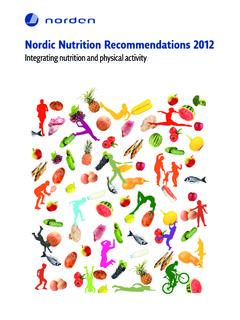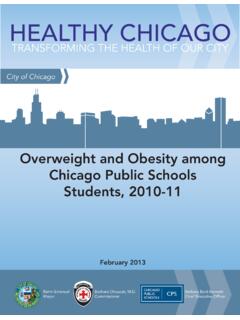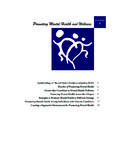Transcription of Compendium of Physical Activities: an update of activity ...
1 Compendium of Physical Activities: an update of activity codes and MET intensities BARBARA E. AINSWORTH, WILLIAM L. HASKELL, MELICIA C. WHITT, MELINDA L. IRWIN, ANN M. SWARTZ, SCOTT J. STRATH, WILLIAM L. O'BRIEN, DAVID R. BASSETT, JR., KATHRYN H. SCHMITZ, PATRICIA 0. EMPLAINCOURT, DAVID R. JACOBS, and ARTHUR S. LEON. Department of Epidemiology and Biostatistics, Departmenlt of Exercise Science, School of Public Health, University of South Carolina, Columbia, SC 219208; Stanford Centerfor Research in Disease Prevention, School of Medicine, Statford University, Palo Alto, CA 94304; Division of Kinesiology, School of Kinesiology and Leisure Studies, University of Minnesota, Minneapolis, MN 55454; Division of Epidemiology, School of Public Health, University of Minnesota, Mintieapolis, MN 55455; Department of Exercise Science and Sport Management, University of Tennessee, Knoxville, TN. 37996; Department of Human Peifoirmance, University o Alabama, Tuscaloosa, AL 35487. ABSTRACT.
2 AINSWORTH, B. E,., W. L. HASKELL, M. C. WHITT, M. L. IRWIN, A. M. SWARTZ, S .J. STRATH, W. L. O'BRIEN, D. R. BASSETT, JR., K. H. SCHMITZ, P. O EMPLALNCOURT. D. R. JACOBS, JR., and A. S. LEON. Compendium of Physical activities: an update of activity codes and MET intensities. Med. Sci. Sports Exerc., Vol. 32, No. 9, Suppl., pp. S498-S516, 2000. We provide an updated version of the Compendium of Physical Activities, a coding scheme that classifies specific Physical activity (PA) by rate of energy expenditure. It was developed to enhance the comparability of results across studies using self-reports of PA. The Compendium coding scheme links a five-digit code that describes Physical activities by major headings ( , occupation, transpor- tation, etc.) and specific activities within each major heading with its intensity, defined as the ratio of work metabolic rate to a standard resting metabolic rate (MET). Energy expenditure in MET-minutes, MET-hours, kcal. or kcal per kilogram body weight can be estimated for specific activities by type or MET intensity.
3 Additions to the Compendium were obtained from studies describing daily PA patterns of adults and studies measuring the energy cost of specific Physical activities in field settings. The updated version includes two new major headings of volunteer and religious activities, extends the number of specific activities from 477 to 605. and provides updated MET intensity levels for selected activities. Key Words: EXERCISE, EXERTION, ENERGY EXPENDITURE. T he Compendium of Physical Activities was devel- oped to facilitate the coding of Physical activities sents measured MET intensities for some activities in which METs were estimated from similar activities. The updated (PAs) obtained from PA records, logs, and surveys Compendium also reflects public health interests in evalu- and to promote comparison of coded Physical activity in- ating the contributions of various types of Physical activity tensity levels across observational studies (1). The Compen- to daily energy expenditure by providing additional catego- dium provides a coding scheme that links a five-digit code, ries for activities done during the day.
4 Representing the specific activities performed in various The initial Compendium has received widespread accep- settings, with their respective metabolic equivalent (MET) tance among PA specialists in the exercise science and intensity levels. Using the definition for a MET as the ratio public health fields. For example, in the United States, the of work metabolic rate to a standard resting metabolic rate coding scheme has been used to identify MET intensities for of ( kJ) kg 5-h- 5 , I MET is considered a resting PAs in the third National Health and Nutrition Examination metabolic rate obtained during quiet sitting. Activities are Survey (6), the 1991 National Health Interview Survey (11), listed in the Compendium as multiples of the resting MET the Paffenbarger College Alumni Study (15), and to evalu- level and range from (sleeping) to 18 METs (running at ate the accuracy of the Minnesota Leisure Time Physical mph). activity Questionnaire (MN-LTPA) (26). Internationally, We provide an update of the initial Compendium of the Compendium has been used to identify MET intensities Physical Activities, developed in 1989 and published in for activities listed in the MONICA Optional Survey of 1993.
5 The updated Compendium reflects additional activi- Physical activity (MOSPA) (12). The coding scheme and ties identified by researchers in the past 10 years and pre- MET intensities for activities listed in the Compendium of Physical Activities also have been published as an appendix 0195-913 l/00!3209-0498/0 or abstracted as a chart in several books (18-20,34). MEDICINE &SCIENCE IN SPORTS & EXERCISE, In their landmark 1995 paper that presents the recommen- Copyright e 2000 by the International Life Sciences Institute dation of the Centers for Disease Control and Prevention S498. (CDC) and the American College of Sports Medicine (ACSM) TABLE 1. Major tvpes of activities in Version 2 of the Compendium of Physical Activities. new major headings are italicized. for adults to accumulate at least 30 min of regular, moderate- intensity Physical activity on most days of the week, Pate et al. 01-Bicycling 08-Lawn and Garden 15-Sports 02-Conditioning Exercises 09-Miscellaneous 16-Transportation (23) cite the Compendium as a reference that researchers, 03-Dancing 10-Music Playing 17-Walking clinicians, and practitioners can use to identify examples of 04-Fishing and Hunting 11-Occupation 18-Water Activities 05-Home Activities 12-Running 19-Winter Activities moderate intensity Physical activities.
6 06-Home Repair 13-Self Care 20-Religious Activities The updated Compendium includes two additional major 07-Inactivit 14-Sexual activity 21-Volunteer Activities headings and 129 new specific activities. It also provides modifications of 94 codes in the 1993 Compendium , adding or deleting specific activities or providing updated MET women, ages 40 yr and older. The new categories include 43. levels. The new major headings and most of the specific specific activities that are culturally and socially relevant activities were identified from studies using PA records to among ethnic minorities and/or older adults. Religious and identify daily PA habits among adults ( ) and from per- ceremonial activities play a central role in the lives of many sonal communications from other investigators who re- older adults, especially among ethnic minority groups (5). ported activities omitted from the initial Compendium . Up- Among retired people and others not employed in occupa- dated MET levels were obtained from laboratory and field tional settings, volunteer activities also commonly represent studies designed to measure the energy cost for specific PAs an important contribution to daily energy expenditure.
7 (4,7-9,16,17,21,22,24,27-30,32,35,37). We have also clar- Specific activities. The updated Compendium con- ified the meaning of the letter T followed by three numbers tains 605 specific activities, including 129 new activities ( , TOIO) as activities and their associated MET levels added to the 1993 Compendium . Modifications were also defined by Dr. Henry Taylor for the MN-LTPA (31). The made to 94 PAs listed in the 1993 Compendium , which letter T is now replaced by the words Taylor Code and involved adding or deleting specific activities associated followed by the MN-LTPA survey item number ( , Tay- with each code. For example, for the code 08030, lawn and lor Code 010). In this paper we present the updated Com- garden activities, the phrase "wheelbarrow chores" was pendium of Physical Activities (Appendix 1) and recom- added to the 1993 Compendium 's specifications of clearing mendations for its implementation to identify PA habits land and hauling branches. In other cases, activities were using PA records.
8 Removed from existing codes and new codes were devel- oped if the removed activities had a different MET level or CODING SCHEME were qualitatively different from other specific activities listed for the code. For example, the 1993 Compendium activity coding. The reader is referred to the 1993 listed mopping as a specific activity in code 05020, home published version of the Compendium (1) for a detailed activities. However, Emplaincourt (7) measured the MET. description of the coding scheme, organization, and meth- intensity for mopping as METs and the MET intensity ods used to calculate the energy cost of PAs. Briefly, the for the other activities in the code was listed as METs. Compendium is organized to maximize flexibility in coding, Thus, mopping was deleted from code 05020 and a new data entry, and interpretation of energy cost for each class code, 05021, was created. Another example is watching and type of PA. The coding scheme employs a five-digit television. In 1993, watching television was coded as 07010.
9 Code to categorize activities by their major purpose or head- (reclining) or 07020 (sitting) and was grouped with other ing (first two digits), specific activity (last three digits), and specific activities that involved sitting quietly ( , riding in intensity (separate two- or three-digit column). For example, a car, listening to a lecture or to music) or reclining and the five-digit code, 06100, is defined as follows: doing nothing. Because watching television is a sedentary Mj but modifiable leisure time activity that may be related to 06. H S 0 si. the increased prevalence of Physical inactivity (36), over- Home Repair Cleaning Gutters weight, and obesity in the United States (13,14), the authors felt that watching television should have a separate code to Based on the model proposed by Pate et al. (23) for monitor time spent in this activity . In the updated Compen- classifying the MET intensity of PAs (light, < 3 METs; dium, the codes 07010 and 07020 refer to watching televi- moderate, 3-6 METs; vigorous, > 6 METs), the activity sion only.
10 New codes have been added for the remaining code 06100 is classified as moderate intensity, inactive reclining (07011) and sitting (07021) activities. Major headings. Two additional major headings were Table 2 presents the new five-digit codes, and Table 3. added to the updated Compendium of Physical Activities for presents the modifications for existing codes as incorporated a total of 21 major types of PAs (Table 1). in the updated Compendium . The two new categories, religious activities and volunteer Intensity of activities. All activities are assigned an activities, were identified from the use of PA records in the intensity level based on the rate of energy expenditure Cross-Cultural activity Participation Study (CAPS) (2). expressed as METs. Intensity of activities in the Compen- CAPS was an observational study of PA habits among dium is classified as multiples of I MET or as the ratio of African American, Native American, and Caucasian the associated metabolic rate for the specific activity divided Compendium OF Physical ACTIVITIES: update Medicine &Science in Sports &Exercise S499.






